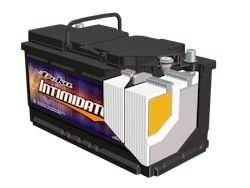Understanding the basics of the 12V system
With so much focus on electric vehicles (EVs) and high-voltage batteries, we must not forget that the 12V system is still the most common battery type and will remain a critical component on many vehicles in the future.
It will be important to build upon what we learned regarding the testing, servicing and replacement of the components within the vehicle’s starting and charging system so we can accurately test and diagnose issues on today’s vehicle. But what has changed and how does it affect how we service a vehicle?
The vehicle has three main components: The battery, which is an electrical storage device; the alternator, which charges the battery and supplies operating voltage to all the circuits while the engine is running; and the starter, which is an electrical motor used to start the engine.
The battery is the lifeblood of the electrical system
The battery is the lifeblood of the electrical system. Although they may come in a variety of sizes and outputs, the battery technology has remained relatively the same. What we consider a 12V battery is actually a 12.6V battery. It consists of six cells, each 2.1V.
The most traditional type of battery is the flooded lead acid battery. The construction of this battery consists of positive and negative plates with separators to prevent the plates from touching. The plates are partially submerged in the acid, which creates a chemical reaction that generates electricity. The electricity flows in and out of the battery through the posts, which can be top posts or side posts.
In addition to the flooded lead acid battery, there are a few other styles. The enhanced flooded battery (EFB) is similar to the flooded lead acid style, but carbon additives dramatically improve the cyclic durability. This design is great for applications that are equipped with a start-stop feature.
The next tier of batteries is an AGM, or absorbent glass mat battery. This style of battery uses an ultra-thin glass mat as the negative plate. Because of the ultra-thin plate, you can have more plates in the same size case, which dramatically increases its performance. The last style and newest technology is a lithium-ion battery. These batteries use lithium manganese oxide as an electrode. The use of lithium has several advantages over the aforementioned batteries. Each cell can deliver 3.6V, which makes for higher voltage applications. They also have a far extended cycle life and the ability to put out 100 percent of their rated capacity, regardless of the rate of discharge.
Lead-acid batteries typically provide less usable energy with higher rates of discharge. Lithium-ion batteries have a slower rate of discharge and recharge at a faster rate than a conventional battery.
Battery testing
Battery testing is critical to help motorists avoid being stranded. Batteries often fail during cold winter months, but that is not the only time you should test a battery. Summer heat plays a big role in the degradation of a vehicle’s battery, which can be detected with just a few tests.
A common test is a battery capacity test. If you are using a tester with a carbon pile, you will determine the cold cranking amps (CCA) of the battery and apply half of those CCA for 15 seconds, watching the voltage to ensure it does not drop below 9.6V. If you have a conductance tester like the one in the image, you simply choose the capacity test, enter the battery capacity and let the tool do the rest. An important test throughout the system is a voltage drop test. This tests the voltage loss across a circuit.
On a top-post battery, you can test the voltage loss between the battery post and the battery terminal with the use of a multimeter. To perform the test, you place the positive lead on the positive post and the negative lead on the positive terminal. Crank the engine while recording the voltage. The specification may vary but is typically no more than 0.2 - 0.5V. You can repeat the test for the negative post by placing the negative terminal on the negative post and the positive terminal on the negative terminal. Lastly, it is always important to ensure the battery is clean and terminals are tight. A good inspection can find these issues before they become a concern.
The alternator: turning mechanical energy into electrical energy
The next component in the system is the alternator. The role of the alternator is to turn mechanical energy into electrical energy. The alternator is driven off the crankshaft by a belt and the pulley is attached to the armature. As the armature rotates through windings, electricity is generated as alternating current (AC) which is then converted by the internal rectifier to direct current (DC). This direct current is then sent to the battery to recharge it, along with supplying the vehicle with its operating voltage.
Alternators have remained the same in recent years except for nuances such as water-cooled alternators. But a more common trait that has impacted the system is the use of the decoupler pulley. This evolution of the pulley is able to decouple from the engine during deceleration, which puts less of a strain on the belt and the tensioner. Some models incorporate a spring to reduce harmonics.
Alternator testing
Testing an alternator is pretty straightforward. The first thing is to ensure the alternator is producing current to recharge the battery. You can do this by placing a high-current amp clamp around the positive cable that connects the alternator and battery. While operating the vehicle’s accessories, you should see an increase in amperage produced by the alternator.
Another test is a voltage drop test. Similar to the test we did on the battery, you simply put the positive lead on the alternator terminal and the negative on the positive battery post. Run the engine and adjust the carbon pile to the output rating of the alternator. Record the results and compare them to the specification.
The last test can be critical as it may affect more than just the charging system. As mentioned earlier, one of the jobs of the alternator is to convert A/C voltage into D/C voltage. If the alternator fails to do this, the electrical system will have too much A/C voltage and could cause all types of issues. The best way to test this is with an oscilloscope. Connect the positive lead to the positive alternator terminal and the negative lead to the battery ground and run the vehicle. You should see less than half of an A/C volt. Your pattern should be a consistent ripple. If you have over half of a volt, the alternator is faulty.
The starter: turning electrical energy into mechanical energy
The starter takes electrical energy from the battery and converts it into mechanical energy so that it can rotate the engine. Modern starters are permanent magnet motors with a gear reduction. This allows a small amount of current to be applied to the solenoid and a large amount of current to leave the battery and turn the armature that engages the flywheel or flex plate.
Starter testing
To test or diagnose a starter, there are a few things to do. First, ensure you have battery voltage at the control side (small wire) of the solenoid. With the ignition in the start position, you should have battery voltage. With the ignition off, you should have zero voltage. If you do have battery voltage in the start position, you should check to see if the amperage is flowing from the battery to the starter. If there is no amperage, the starter is faulty.
The last test is another voltage drop test. This time, you will place the positive lead of the meter on the battery positive post and the negative on the positive starter post and engage the start position, record your voltage, and compare to the specification. Again, the specification can range from 0.2V - 0.5V.
I know we are eager to learn how EV vehicles operate and how to service them, but the 12V system is still overwhelmingly prevalent and will be for years to come. Of course, there are additional tests. But with the tests outlined in this article, you can confidently troubleshoot most issues within the starting/charging system.
About the Author

Jeff Cox
Jeff Cox is the president of the Automotive Maintenance and Repair Association. Jeff has been in the automotive aftermarket industry for 25 years, starting as a technician before transitioning to leadership. Jeff is an ASE Master Technician and holds a bachelor’s degree in Automotive Technology from Southern Illinois University. He also holds a master’s degree in Organizational Leadership. Jeff and the AMRA team are dedicated to helping build trust between the customers and the repair shop through their Motorist Assurance Program, better known as MAP.

